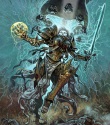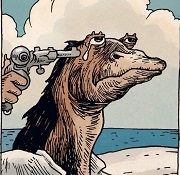|
Ainsley McTree posted:Stuff like this is one of those interesting things that I learn about now as an adult that wasn't mentioned at all in (American public) school growing up. Just as the European theater was the heroic story of d-day, where America and friends heroically turned the tide of the war and relieved Russia of whatever it was they were doing on the other side, nobody can really say for sure, probably eating wallpaper and shooting each other for cowardice or something, the Pacific theater was a series of heroic sea battles and island landings, which we won eventually. Also the japanese were doing...something, in China, to which America heroically sent some airplanes. https://en.wikipedia.org/wiki/Second_Sino-Japanese_War Check out the casualties column. You're talking something around 400-700k dead, 2m total casualties for Japan and 1.3m KIA, 3.2m total for the Republic of China. Add another half million or so for the PRC. Note that these are combat deaths and don't factor in the god awful civilian casualties.
|
|
|
|

|
| # ? Jun 10, 2024 22:36 |
|
yeah China was hell for everyone involved. Like when Chaing decided to blow up major dams in an attempt to cause a flood to slow the Japanese advance. Literally hundreds of thousands of Chinese people died as an indirect result and it turned out that the Japanese probably couldn't have advanced anyway, but Chaing was willing to take the risk even though he knew the consequences. This isn't meant to condemn the Nationalists (although let's be fair it was totally hosed up), but rather to give a sense of perspective on the scale of the fighting in China. And on top of that the Chinese fought for almost twice as long as the United States did.
|
|
|
|
WW2 Data USA 6-inch projectiles is up. Which round was reserved specifically for submarines? What round used a noes cap for moisture-proofing purposes? All that and more at the blog!
|
|
|
|
Murgos posted:Maybe I shouldn't have used the last months of the war as my example? How about the first land action at Guadalcanal where the Japanese sent 2000 men at the end of a long and tenuous supply line against 15000 Marines in strong defensive positions protected by some of the most inhospitable jungle on the planet? You may have seen my post praising(?) Bernard Montgomery earlier, he was taking over an army that had just squandered 50,000 soldiers botching a fight against a materially inferior enemy. 35,000 soldiers at Tobruk surrendered in the aftermath of Gazala because their CO literally prissed around for weeks without preparing a proper defense. A popular British Cavalry move was to take a fresh brigade of armoured vehicles and send them directly into established German fortifications, while deliberately refusing infantry cooperation and also being late. Hell, the 7th armoured were doing this in Normandy, but with slightly better at/infantry support so the swift German counterattacks at least bought it in equal numbers. Also, why would the IJA ever have materiel superiority to the Americans after 1942? The American got to choose where to apply overwhelming force, seeing as Midway took care of the IJN. Guadalcanal, iirc was completely unsustainable for the Japanese and they couldn't have built up the necessary supplies to actually force the American off the island. There was nothing in the Pacific War besides "Try to kill enough Americans to wear them out". Perhaps Japan should have sued for peace, but so should have Nazi Germany.
|
|
|
|
I think it's fair to push back at turning Japanese behavior during WW2 into something exotic, but that shouldn't go so far as to argue the high command ran the war in anything resembling a competent or coherent manner. Japan's strategic options definitely narrowed considerably over time, but even within those constraints their choices were wasteful, and they tended to repeat the same mistakes. This extended to their campaigns on the mainland, where they repeatedly squandered what advantages they had. At no point, as far as the records show, was there ever an honest discussion in the Japanese high command about strategic realities. The Japanese were lead by a brutal authoritarian regime, and like most such its leaders were more interested in self aggrandizement and avoiding blame than anything else. It had also instilled in the rest of the society a sense of fanaticism that lead to behavior in the field that was both vicious and counter productive. They did this by leaning heavily into certain aspects of Japanese culture and their societal mythos, which gave credence to the idea of never admitting error and relying on spirit over good planning. That gives their authoritarianism a particular character that is uniquely Japanese and that can stand some examination too, though it's certainly as understandable as the perverse incentives that drove military behavior the Third Reich or the Soviet Union.
|
|
|
|
Throatwarbler posted:It's almost as if the Japanese didn't go through the WW1 battles that taught everyone else the whole "Elan != bulletproof" thing. On the contrary, they went through the Russo-japanese war were they faced strong defenses at Port Arthur and took them after frontal attacks and heavy losses. So they sorta believed that Elan can carry the day no matter what.
|
|
|
|
Part of it was definitely the IJA-IJN rivalry where neither side were giving complete information to each other, but then again there just seemed to be an old-fashioned contempt of logistics as being beneath the attention of true soldiers, or whatever. I mean the Japanese lost something like 125,000 men in the New Guinea campaign almost entirely to disease and starvation.
|
|
|
|
They weren't really able to move men & supplies around the Pacific as easily as they originally expected. After Midway & the losses during the Guadalcanal campaign, the guys on the outlying islands were pretty screwed since all their supplies were under attack from the air & from subs. I mean, at Guadalcanal they were using destroyers as transports b/c freighters couldn't get there and back without getting attacked from the air, and later on in New Guinea, same thing. Allies probably should have ignored New Guinea like they did Rabual, but, hey, idle hands are something something, I guess. And it's not like they didn't learn, they switched over to tenacious D pretty soon after Guadalcanal, with the idea of convincing the US that the game wasn't worth the candle so they could go to the negotiating table. But unfortunately, the US wasn't having any of that, and they had made the mistake of tying them to ze germans, so the US wasn't going to give them a separate peace.
|
|
|
|
Saint Celestine posted:On the contrary, they went through the Russo-japanese war were they faced strong defenses at Port Arthur and took them after frontal attacks and heavy losses. Yea, and the Battle of Tsushima was the kind of decisive battle they were banking on winning against the US Navy too. They really took the wrong lessons away from it.
|
|
|
|
HEY GAIL posted:what's arabic for loving weeb Wahaboo? 
|
|
|
|
Thank the gods, we're back to knifing chat  Cyrano4747 posted:edit: reminder that a US Marine stabbed a bunch of insurgents to death with a pocket knife 4 or 5 years ago in Iraq. Wait till you get a load of this Mycroft Holmes posted:The puukko has also given the root for Finnish language verb puukottaa, "to stab (with a knife)" or literally "to knife". My mum who went to school in the sixties was taught to beware of finns, because they 'more easily recoursed to the knife'. When she told me I was watching a documentary on the winter war, and I we had a good laugh about how silly it was. Then, minutes later, they interview a member of the woman's auxilary corps, who suddenly says "if we caught an enemy behind our lines, we gave him with the PUUKO!", and brandishes a huge gently caress-off knife with a manic gleam in her eyes. That was.. something 
|
|
|
|
Part 2 Previous post here --- 26.2. 00.30: We arrived at the HQ dugout of the 3rd Jaeger Battalion, where captain Kunnas came up with his plan of attack. He divided the battalion into two battlegroups. Two rifle companies, led by lieutenant Vainio, would attack from the railroad with the objective of reaching lake Näykkijärvi. A single rifle company, lef by lieutenant Hynninen, would attack along the railway and thus secure the left flank. Machineguns were attached to both battlegroups. The battlegroup of lt. Vainio would be supported by the I and III tank platoons (total 9 tanks) and the battlegroup of lt. Hynninen would be supported by the II tank paltoon (total 4 tanks). It was agreed, that the tanks would lead the charge and the infantry would follow immediately behind. The attack was to start at 05.00. 01.15: I arrived at the company, where refueling was still going on. I gave the platoon leaders a briefing of the mission using a map. The platoons supporting lt. Vainio's battlegroup would be organized with I platoon on the right and III platoon on the left. The platoons would drive from the road to the railway in a line and form a line after crossing it. After reaching the objective of the 3rd Jaeger Battalion, the platoons would turn at the shore of the lake and wait for fresh infantry to arrive from behind. II platoon would drive over the railway in a line and then turn to face the direction of the railway. After the fresh infantry arrived, it would support their push for the objective. I further suggested that the platoon leader's tank would drive as the right-most vehicles, so that the drivers could keep in contact with their right side. At the same time, I reported that the tanks would go first, followed by the infantry. I emphasizing that if the infantry gets left behind, the tanks must return to it and attempt to pull it behind. (Appendix 4) I ordered that the company would move to Juukkala. (Appendix 2). Order of march: I platoon, III platoon, II platoon. Leave at 02.15. Mechanics and cars would stay at the Karhusuo railway stop. 02.15: The company leaves for Juukkala. Approx. 04.30: Eight tanks arrive in Juukkala. Five tanks got left on the way, of which one could not start the march and four got left on the road. I received a report of engine problems, which could not be solved despite attempts to do so. This left 6 tanks to support the battlegroup of lt. Vainia and 2 tanks to support the battlegroup of lt. Hynninen. After contacting captain Kunnas, I reported that only 8 tanks had arrived. He reported that the attack would be postponed as he had not been able to contact artillery and the sapper group had not yet arrived. The attack was ordered to start at 06.15. I reported this change to the platoon leaders and ordered them to start at 06.00, for that is when the artillery preparation would begins, and thus the starting up would be covered. 6.00: Platoon leaves for the attack. Two more tanks were left to Jukkala due to engine trouble, so that only 6 tanks could take part in the attack. 4 tanks supported lt. Vainio and 2 tanks supported lt. Hynninen. The movements of the tanks are shown in the the map (Appendix 5). Actions of the tanks: Tank number 648, commanded by reserve lieutenant V. Mikkola, who was wounded during the battle has provided the following after action report of the battle via letter on 24.3.1940: Res.lt. V. Mikkola, commander of tank number 648 posted:Some two hundred meters beyond the railway, we immediately found some Russians, for I noticed a tent into which I fired a specially sensitive grenade. From the tent came out a damned large amount of Russians, who I suppose were attempting to surrender as they had their hands above their heads. The machinegunner took care of them and the small Russians went down holding their stomachs and stayed there. I now noticed that there were right next to us two Russian tanks. I reported them to corpolar Linkohaara. The turret turned, and I think that Linkola, despite firing with the cannon, failed to hit. We moved on the first gear, so that shouldn't have been a problem either. Reserve lieutenant V. Mikkola had to spend the whole day, wounded, behind the Russian lines and only managed to get to friendly lines when the night came. The rest of the tanks crew, res.cpl. A. Linkohaara, res.pfc. E. Numminen and res.pvt. M.E. Mäkinen were lost in action. Tank number 668, commanded by res.cpl. M. Pietilä got stuck against a large tree. The tank failed to run over the tree, so the men chopped it down with axes. This, however, resulted in a stump so large that the tank was stuck on it. Res.cpl. E. Salo fell near the tank. Once the crew was unable to get the tank moving, they made for the starting point. Only res.pvt. E. Ojanen made it to friendly lines, after wandering around for some 24 hours. Res.cpl. M. Pietilä and Res.pvt. A. Aalto are missing in action. Tank number 664, commanded by res.cpl. Rassi, advanced to a ditch some 75 meters from the railway, but was unable to cross it despite multiple attempts. After then determining that the infantry was not following, the tank returned on its own tracks to the railway and tried from another place. The turret then got immobilized and so I ordered the tank to return to Jukkala. Tank number 670, commanded by res.2nd.lt. S. Virmio, reached the edge of the clearing and determined that the infantry had failed to follow. The tank returned along its own tracks. It started again and then saw enemy men going to both a cellar and a log-covered hole. Fragmentation grenades, machine guns and submachineguns were fired at these targets from the tank. The tank again returned to retrieve friendly infantry, and started a third time. This time, it moved more to the left and got into a fight with some Russian tanks. The gunner likely got a hit on one of the Russian tanks, for it started to quickly fall back. However, tank number 670 was hit from somewhere in the right, resulting in the wounding of res.2nd.lt. S. Virmio and the turret being immobilized. The tank started to retreat towards the jump-off point, but was hit in the engine compartment and the engine halted. The crew was forced to leave the tank. Under heavy enemy fire, the men were unable to transport res.2nd.lt. Virmio to the friendly lines. However, he had later managed to reach the friendly lines and is now already on leave recovering. Tank number 655, commanded by res.2nd.lt. O. Voionmaa, crossed a clearing on the side of the railway and stayed on the edge of the forest waiting for the infantry. It destroyed at least two machine gun nests, pointed by the infantry. Some time later the tank was hit in its turret and a bit later in its engine compartment, resulting in a fire. The crew was forced to abandon the tank. The driver, res.pvt. V.S. Mäkinen brought with him both submachineguns and even the action of the machinegun, thus ensuring it could not be used. Tank number 667, commanded by res.cpl. E. Seppälä, followed the platoon leader's tank to the edge of the forst. Once it noticed that the infantry was not following, it returned to the railway and tried again. However, near the railway, it was hit first in its turret and second in its drive wheel, resulting in an immobilized tank. The tank was then used as an immobile pillbox. Res.cpl. E. Uutela (driver of tank number 670) moved to this tank of his own accord and acted as a gunner. He fired at machine guns pointed out by the infantry as well as passing Russian tanks, at least one of which was destroyed as it caught on fire. Another tank was also hit, as it was immobilized. Tank n.667 was then hit multiple times, so there was no possibility of towing it back. In this battle, the company lost two officers wounded and one reserve corporal killed. Two reserve corporals and 3 reserve privates were lost in action. In terms of lost material, five tanks were lost with armaments, as was some crew equipment that was stored in the tanks. The attack failed. I believe the largest reason was the lack of preparation. None of the commanders was able to reconnoitre the area beforehand. The artillery preparation hit friendly infantry. Maybe that, too, could have been prevented with proper reconnaissance. You see, when planning the attack, it had been suggested that the enemy had reached some 200 to 300 meters north of the railroad. In the area, it was however determined that the grounds north of the railroad were in friendly hands. Naturally, the friendly infantry got as close to the railroad as possible. The friendly artillery, however, was not told of this and this probably explains the poor accuracy of the fire. The infantry completely lost its morale. Instead of starting an attack, it started to evacuate both the killed and the wounded. The failure of the company is in my view explained by the following reasons: The terrain was too difficult, resulting in the light tanks being unable to operate everywhere. It is my opinion that the tank operations would have been efficient if proper reconnaissance had been conducted. At the least this would have allowed us to agree beforehand on the routes of advance for the tanks. The taking of the attack formation should have been conducted in-place, but that again would have required reconnaissance. Due to the lack of time, the formation was changed on the move and the results were as one expects. Anyone who has visited a tank would presumably agree that it is near-impossible to do map-orientation from one. I suspect that the company's mission would not have succeeded any better even if all the tanks had been available. I am convinced that even the attack supported by the 6 tanks would have succeeded if the infantry had at least attempted to follow the tanks. Finally, I believe it is important to note that the company was thrown into combat immediately after it arriver in the front, which further lowered its combat ability. It would have been likely a good idea to allow for the 4th/Arm.Bt. to conduct at least one training attacktogether with the 3rd Jgr.Bt. After such a joint exercise, the results would have surely been completely different. Approx. 15.00: In a telephone call with major Haahde, I was ordered to collect the company. I ordered the company to assemble at the Karhusuo stop. Enemy air was very active and caused delays. Approx. 20.00: I managed to assemble the tanks. It was then determined that the fuel was contaminated with water, thus explaining all the trouble. I sent an order to the supply elements to acquire new fuel. After the company was fed, the men were billeted in nearby cottages with orders that the fuel must be changed as soon as the new fuel arrives. After this, I tried to contact the division headquarters to report the status of the company. I was unsuccessful, as the communication lines had been cut. I did not know where the division HQ was located, and was thus unable to go there in person. --- Appendix 2:  Appendix 4:  Appendix 5:  Loezi fucked around with this message at 13:54 on Oct 17, 2017 |
|
|
|
Class Warcraft posted:Part of it was definitely the IJA-IJN rivalry where neither side were giving complete information to each other, but then again there just seemed to be an old-fashioned contempt of logistics as being beneath the attention of true soldiers, or whatever. I mean the Japanese lost something like 125,000 men in the New Guinea campaign almost entirely to disease and starvation.
|
|
|
|
Also bad priorities w.r.t. branch design and fleet strategy, the ships in place had a hard time getting through U.S. air power and blockades.
|
|
|
|
Cyrano4747 posted:old RN maps of the area that didn't show important things like the presence of some dense loving jungles and rugged mountains in the middle of the island. Because the RN didn't care about anything that wasn't the coast?
|
|
|
|
The Lone Badger posted:Because the RN didn't care about anything that wasn't the coast? Sea maps or nautical charts are not concerned with jungles or mountains. Nautical charts show the features of seabed and details of coastlines. Things which are important for safe maneuvering of ships. Jungles are irrelevant since you won't take your ship through the jungle anyway. Unless you are Fitzcarraldo.
|
|
|
Loezi posted:Tank number 668, commanded by res.cpl. M. Pietilä got stuck against a large tree. The tank failed to run over the tree, so the men chopped it down with axes. This, however, resulted in a stump so large that the tank was stuck on it. Res.cpl. E. Salo fell near the tank. Once the crew was unable to get the tank moving, they made for the starting point. Only res.pvt. E. Ojanen made it to friendly lines, after wandering around for some 24 hours. Res.cpl. M. Pietilä and Res.pvt. A. Aalto are missing in action. When 16% of your total armored force is stymied by a single tree, you may want to rethink your battle plan.
|
|
|
|
|
668's performance is really just perfect.
|
|
|
|
HEY GAIL posted:that's not contempt for logistics, that's overstretched logistics and no supplies
|
|
|
|
Japan also had a tiny merchant navy to begin with, relative to its military and the size of its planned empire, and it was further cut down because when Japan started attacking the Western powers, a good amount of their ships were in Allied ports and promptly seized. One reason Midway was such a godawful bad idea, it would have been extraordinarily difficult to keep in supply and then further shat on Japan's logistical capability because there's nothing on Japan worth shipping home. And yes, the IJN did not consider protecting their merchants, using convoy systems, or hunting submarines to be an important use of their time or effort. Why worry about this stuff when you're going to knock your enemies out of the war in one big battle?
|
|
|
|
Tias posted:Thank the gods, we're back to knifing chat The Russian word for switchblade is Finka (female Finn), so I can believe that.
|
|
|
|
Cythereal posted:One reason Midway was such a godawful bad idea, it would have been extraordinarily difficult to keep in supply and then further shat on Japan's logistical capability because there's nothing on Japan worth shipping home. I remember a War in the Pacific playthrough where the Japanese player went full Gay Black Hitler and invaded and took Pearl Harbor, only to have it starve because there's a LOT of sub-infested open ocean between the Home Islands and Pearl and it was really hard to get any ships through.
|
|
|
|
Cythereal posted:Japan also had a tiny merchant navy to begin with, relative to its military and the size of its planned empire, and it was further cut down because when Japan started attacking the Western powers, a good amount of their ships were in Allied ports and promptly seized. You sure you're not thinking of the Italians?
|
|
|
|
Jobbo_Fett posted:You sure you're not thinking of the Italians? I'm thinking of both. 
|
|
|
|
Cythereal posted:I'm thinking of both. First time I've heard of them losing "a good amount" of ships to that. 
|
|
|
|
Jobbo_Fett posted:First time I've heard of them losing "a good amount" of ships to that. I went back and checked my books. They only lost a few merchant ships, but they did lose a substantial amount of planned imports that were being carried on Allied-flagged ships that were promptly confiscated. But the Japanese merchant marine was tiny relative to the planned Empire's size, and further pressed by the military impressing many merchant ships for troop transport duty.
|
|
|
Pyle posted:Sea maps or nautical charts are not concerned with jungles or mountains. Nautical charts show the features of seabed and details of coastlines. Things which are important for safe maneuvering of ships. Jungles are irrelevant since you won't take your ship through the jungle anyway. Unless you are Fitzcarraldo. I. WANT. MY. OPERA. HOUSE!
|
|
|
|
|
Cythereal posted:I went back and checked my books. They only lost a few merchant ships, but they did lose a substantial amount of planned imports that were being carried on Allied-flagged ships that were promptly confiscated. But the Japanese merchant marine was tiny relative to the planned Empire's size, and further pressed by the military impressing many merchant ships for troop transport duty. Right, so they lost valuable resources rather than lots of boats and resources. In my searching I did come across this website to see if it led to a Japanese version, and I think its got some good info on the Italians. http://www.regiamarina.net/detail_text_with_list.asp?nid=53&lid=1&cid=5 quote:In August 1939, Germany, because of its failure to provide a precautionary warning to its merchant ships steaming in faraway oceans, had lost over half of them, as they were stranded in neutral ports, captured by the enemy or self-destroyed to avoid capture. The list of "known" locations puts it at 196 ships outside the Mediterranean, while the page states 256. Elsewhere on that same site, they list the Italians as having a merchant navy of 786 ships. So, the Italians lost 25 to 33 percent of their merchant navy immediately when they joined the war. Also, a list of Japanese naval losses of WW2 http://www.ibiblio.org/hyperwar/Japan/IJN/JANAC-Losses/JANAC-Losses-4.html
|
|
|
|
HEY GAIL posted:that's not contempt for logistics, that's overstretched logistics and no supplies There were multiple instances of starving garrisons just being sent extra men instead of supplies, with corresponding letters back to command asking them to please stop sending more mouths to feed. Unless they were just supposed to eat the extra troops...
|
|
|
|
Comrade Gorbash posted:Most modern dress swords are at least in the same shape of either smallswords or cavalry sabers of some kind, both of which are perfectly serviceable weapons. Especially against opponents not wearing armor. Older swords, the "classic" design like arming swords and viking swords etc., were designed to deal with opponents likely to be wearing leather or chain armor of some kind. Plus there was just less knowledge in general of how to optimize a blade. I wrote all this before realizing I was behind on the thread, and I don't care care I wrote this poo poo. This has a lot of misconceptions on the military use of swords. Arming and "viking" swords were not poorly designed due to lack of knowledge. To do the job they were intended to do, they could not be designed much better. Access to steel was the normal limiting factor, not blade design. Armor, and shields dictated the design of swords, and you see less handguards since they were meant to be used with shields and/or gauntlets, so they don't have the hilts you see later. Smallswords were rarely used on battlefields in the 1700's when they were popular. They were rather specialized dueling weapons, intended to be used against another man with a smallsword. They were a way for people to carry a weapon, signify they were ready to defend their honor, and do so, without carrying around a rapier or broadsword. In nearly every way they are a civillian weapon. If they were the only sword you owned, or if you really preferred them, they were indeed carried on the battlefield. In the 1600 going into the 1700s, most soldiers were using rapiers or some form of broadsword. Broadswords are not much different than a medieval arming sword, with a big and protective hilt for the hand. Armies at the time then militarized the smallsword into the Spadroon in the later 1700's. They were basically a larger, heavier blade attached to smallsword style hilt. They also were not around very long as they were replaced by sabers after the Napoleonic wars in most countries. Broadsword Smallsword  Spadroon.  Starting in the Napoleonic period, you have most armies standardizing on a combination of Spadroons for infantry and Sabers for cavalry. During and after the Napolenonic period, you see infantry officers switching to some form of saber. The word saber also starts just meaning "sword" at this point as some of the blades were indeed curved and look like "sabers" while others are nearly to perfectly straight and could be mounted on one of those broadsword hilts and you could not tell the difference. The below 2 are just 2 models, with all the countries using various degrees of curve, size, length, weight, etc depending on their own doctrine and theories. You can go from relatively small, light swords to big heavy shopping blades to essentially a rapier balde on a saber hilt by the time you get to the patton style sabers in the 1900s, which were basically intended to be used as short lances, not as cut and thrust swords. Also light and heavy is still between a general weight range of like 1.5-2.5 lbs. British 1796 light cavalry saber, one of the most popular swords made at the time.  British 1845 Infantry officers saber   Throughout this entire period swords were being made to work at their job. They were not just barely strong enough to hit someone and not break. While standard issue swords varied in quality depending on time, place, model, etc, in general they were intended to be used in combat, and were used extensively in various battlefields around the world. You keep saying "speed is more important than power" and I'm not sure what you mean. A sword of the time needs to be strong enough to parry a bayonet or swung musket butt, long enough to work as a sword, and depending on design, needs enough weight to generate force at the point of impact, to facilitate cutting. The very late swords like Patton's were thrust only. Smallswords were not a good mix, hence the Spadroon, and those still were not good enough, hence the shift to infantry sabers with more developed handguards and robust blades. As for the Katana, they are surprisingly heavy, they have relative short blades, around 30-32 inches, and weigh about 2.5 lbs
|
|
|
|
While we're on sword chat, I loving love gothic style hand guards.
|
|
|
|
|
Jobbo_Fett posted:In my searching I did come across this website to see if it led to a Japanese version, and I think its got some good info on the Italians.
|
|
|
|
Xpos again, last one.... On my 9 hour flight to London, any recommendations for books? I have read recently and enjoyed: Fiasco, Chickenhawk, Dark Sun : Making of the Hydrogen Bomb, The Jungle is Neutral, The Great Game, Tresspassers on the Roof of the World, Relentless Strike, several generic been there done there books from WW1- GWOT, Legacy of Ashes, The Sword and The Shield, The World Was Going Our Way, a bunch of Dick Couch books and yeah. I would enjoy both military history, geo-political stuff and obviously Cold War stuff. I've been eyeing Blank Spots on the Map to start. Someone here recommended me Shooting Leave and if that's on kindle I'll get that. Also taking suggestions for sci-fi and bullshit, I have a dirty love of terrible warhammer novels, terrible military sci-fi....thinking about picking up Jannisaries and Hammers Slammers. I would enjoy military sci-fi, human soldiers in a galactic war
|
|
|
|
I'm just disappointed that the IJA didn't take the concept of the sword bayonet to its logical conclusion and issue a bayonet that made the rifle into a naginata. If you're going for ridiculous warrior spirit gimmicks, don't half-rear end it.
|
|
|
|
Rockopolis posted:I'm just disappointed that the IJA didn't take the concept of the sword bayonet to its logical conclusion and issue a bayonet that made the rifle into a naginata. They put bayonets on LMGs, they tried man. 
|
|
|
|
WoodrowSkillson posted:They put bayonets on LMGs, they tried man. I feel like for a heavy weapon like that, you might as well use an axe head or a halberd or something
|
|
|
|
Murgos posted:So, I only know as much as thread favorites "The Rising Sun", "Shattered Sword" and a few books about the Pacific campaign by Leckie but most of the Japanese commanders at all levels seemed to have a massive over reliance that 'will' and 'spirit' and 'national essence' would allow them to overcome any odds. I'll point out that that seems to be more of a high level thing. Santa Cruz is full of evidence of the Japanese having learned from their earlier battles. I can't fault them for needing things to go wrong to get an idea of what could really bite them, after all the US had to learn from problems at Coral Sea.
|
|
|
|
Waroduce posted:Fiasco, Chickenhawk, Dark Sun : Making of the Hydrogen Bomb, The Jungle is Neutral, The Great Game, Tresspassers on the Roof of the World, Relentless Strike, several generic been there done there books from WW1- GWOT, Legacy of Ashes, The Sword and The Shield, The World Was Going Our Way, a bunch of Dick Couch books and yeah. For embarrassing pulpy military sci-fi, Marko Kloos' Frontline series is pretty solid.
|
|
|
|
Comrade Gorbash posted:The German losses are wince inducing as well, since the same thing happened to them in the First World War, and then they repeated the mistake in a more egregious way. In the Great War, things progressed quickly enough that even if they'd issued better instructions it wouldn't have helped in many cases. In WW2, the Germans were controlling the time table so it's purely poor management. It's not really poor management and more of an indication of how coalition warfare works in the modern world if you're mounting a surprise attack. The Germans couldn't just call back all their merchants in the summer of 1939 in order to minimize losses. To do so would be a giant loving red flag akin to mobilizing and sending the army to the frontier. If you wanted to get into a war with any kind of element of surprise in the 20th century you just had to assume that your merchant marine is going to be caught flat footed as a result.
|
|
|
|

|
| # ? Jun 10, 2024 22:36 |
|
Waroduce posted:Xpos again, last one.... I found Our Vietnam by AJ Langguth a revelation. He has a good narrative style, and he does get into the politics behind a lot of the decisions that were made on both sides. It really opened my eyes to how casual and inept the US was regarding pretty much the entire thing.
|
|
|
































